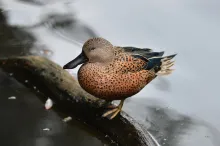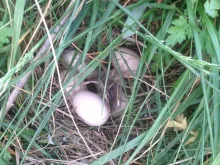
Red shoveler (Anas platalea)
Species name
- Dutch name:
- Argentijnse slobeend
- English name:
- Red shoveler
- German name:
- Fuchs-Löffelente
- French name:
- Canard spatule
- Scientific name:
- Anas platalea
Scientific classification
- Order:
- Anseriformes
- Family:
- Anatidae
- Onderfamilie:
- Anatinae
- Genus:
- Anas
Description
- Description:
Male:
The male has a reddish-cinnamon mantel, breast and belly, heavily spotted black. Back and rump are blackish. A white patch is visible on each side of the vent. The upperwing shows blackish primary flight feathers and green and black secondaries. The upperwing-coverts are pale blue with broadly white-tipped great coverts. The scapulars are elongated and black streaked white.The underwing is white with brownish-tipped flight feathers.The tail is pointed with white outer rectrices and black median tail feathers. Head and neck are greyish and uniform, but the crown may be slightly spotted black. The large, broad bill is black. The eyes are pale bluish-white. Legs and webbed feet are yellow or orange.This species has no eclipse plumage.Female:
The female is slightly different with dull yellowish body. The dark brown feathers are edged pale yellowish, giving a large scaled pattern. The upperwing-coverts are duller than in male, mostly bluish-grey. The secondary flight feathers are darker, greenish-black. The head is similar but the bill is dark brownish. Eyes are dark brown. Legs and feet are dull grey.Juvenile:
Juveniles resembles female. The young male shows more pale blue on the upperwing. The sexual maturity of male and female is one year old.
Standard Measurements
- Body Length (cm):
- The male (drake) of the Red shoveler measures approximately 45-56 centimeters. The female measures approximately 45-56 centimeters.
- Body Weight (grams):
- The male will weight about 520–620 gram. The female will weight about 520–610 gram.
The weight is notoriously variable and can only be used as indication!
- Note:
Dabbling Ducks are generally hardy, easy to maintain and easy to breed. Shelter may be required by some of the smaller species in winter. They should be provided with cover (including marginal pond cover) and loafing areas as well as water. A pen which is 50% water is suggested. The water may be shallow (i.e. no more than two feet deep is required), and muddy areas for dabbling in are also appreciated. These ducks are generally good in mixed collections, although the smaller and quieter species may be bullied. Territorial disputes between ducks of the same species may be avoided by keeping only one pair of each species in an enclosure, unless the area is very large. For a single pair of ducks a pen are of 50 to 100 square metres, depending on the size of duck, should be provided.
Red shovelers are ground nesters and both close ground cover and ground level nest boxes should be provided. Hand-rearing is generally preferred, as these ducks are generally poor parents in captive conditions, particularly in enclosures shared with other waterfowl.
Red shovelers are winter-hardy and peaceable. They prefer fairly shallow muddy water and good marginal pond cover. These ducks are easy to breed; close ground cover and ground-level nest boxes should be provided.
These ducks are prone to hybridization, particularly with closely related species, which should be kept apart from one another. Hybrids have been reported with Cinnamon teal (Anas cyanoptera ) and Cape shoveler (Anas smithii).
- Breeding:
- The female Red shoveler usually lays from 6-8 creamy eggs and incubates them for 25 days.
- Artificial incubating:
The ideal relative humidity for incubating most waterfowl eggs is 55% (ground nesters) and 40% (cavity nesters). The temperature is usually 37.4°C. Set ventilation as recommended by the incubator manufacturer. Eggs must be turned, either automatically or by hand, a minimum of 4 times a day. As the duckling develops there is a loss of water from the egg and the air sac gets bigger. In normal development of an egg with a 25 days incubation, the air sac occupies about a third of it three days earlier. Cleanliness is vital and ideally eggs should be moved to a separate hatcher at this point, where the humidity should be increased to 65% and even higher once they have pipped internally.
- Bird banding:
- Recommended closed leg band ring size for the Red shoveler is 9 mm.The leg band ring can only be applied on a young dabbling duck at around 12 days old.
- It doesn't matter what leg that you band, but it's good to have a consistent system. Suggested: Left leg = Female, Right leg = Male
- Rearingfeed:
-
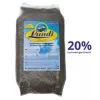
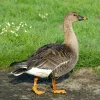

Floatable special rearing feed for all types of aquatic ornamental fowl - especially for the cultivation of trees as well as greening ducks.
This well-balanced complete feed with 20% protein content convinces above all by its good compatibility and forms the basis for visibly healthy growth from day one.
Made exclusively from wholesome and selected raw materials, Lundi Micro Regular is also ideally suited for the year-round feeding of waterfowl.
- Maintenance food:
-



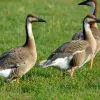

Lundi Regular with a protein content of 20%, valuable Spirulina and high-quality by-products is optimally balanced in its composition maintenance food for water ornamental fowl of all kinds. Especially green teal and Whistling ducks that are not dependent on a very high protein content, are well supplied.
Lundi Regular contains all the minerals and vitamins in full form that are important for the animals. Therefore also suitable as breeding food.


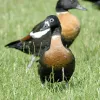


Floating full food for all sea ducks, green ducks, eider ducks and geese, especially in the moulting and breeding phase ideally suited. Packed with wholesome raw materials, natural vitamins and trace elements, this performance food with a protein content of 30% forms the basis for lifelong vitality.


